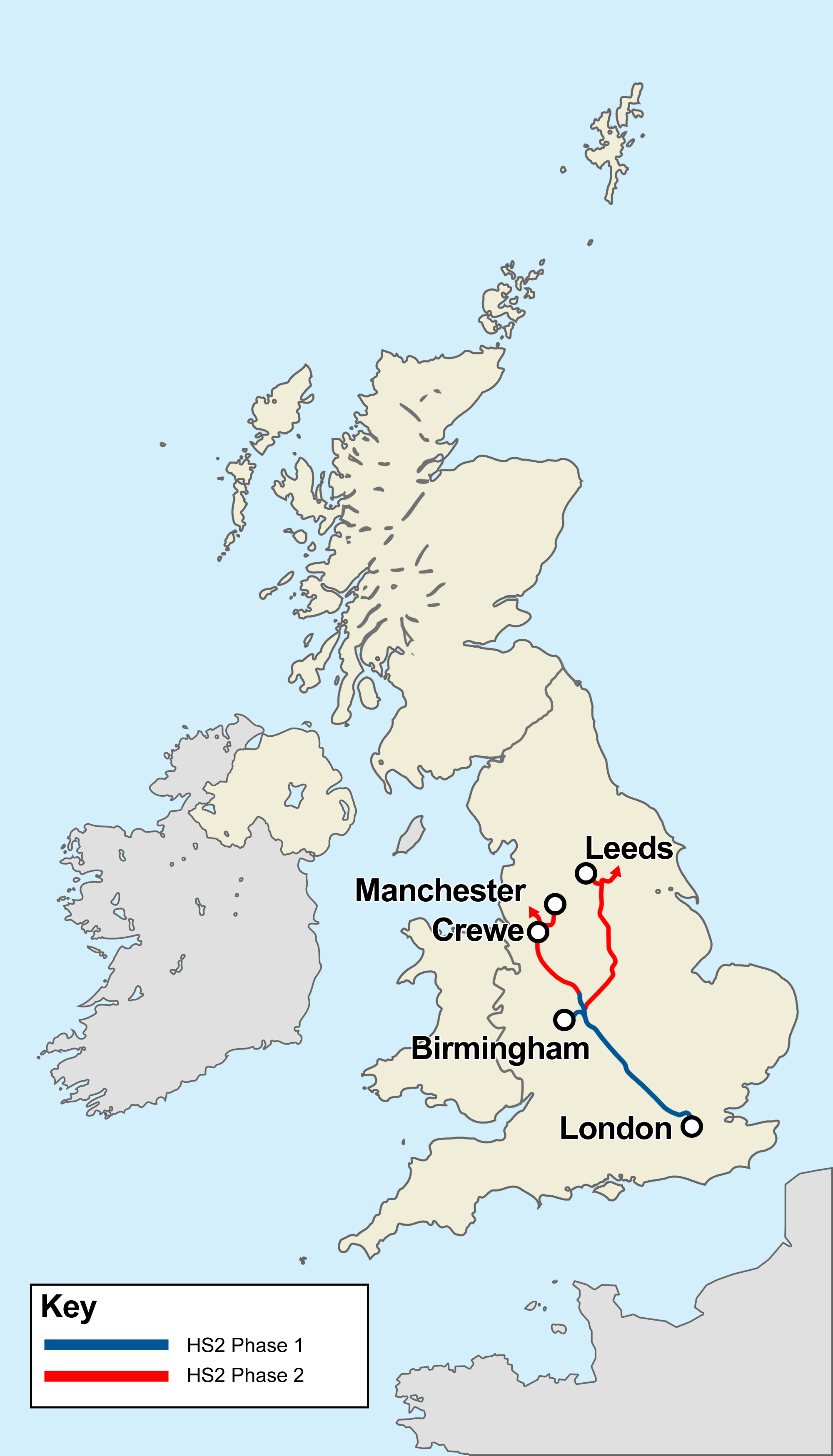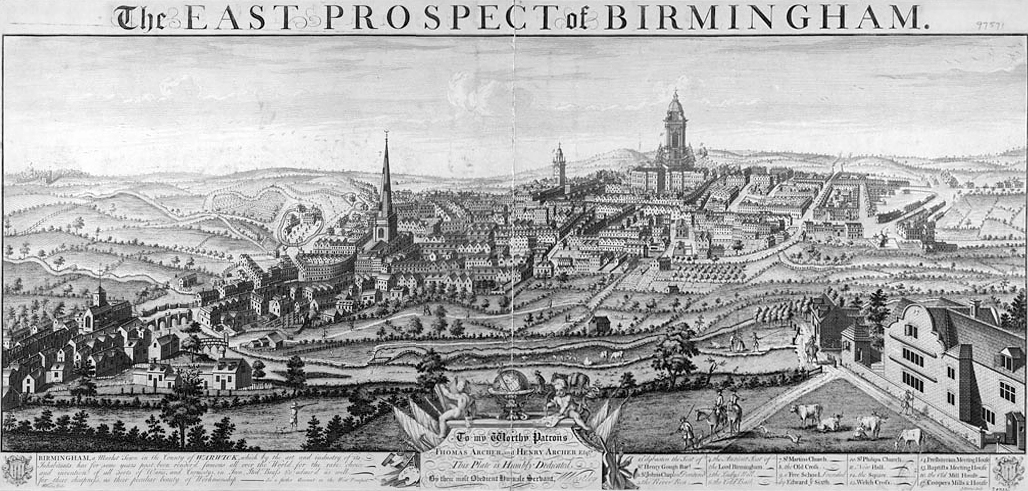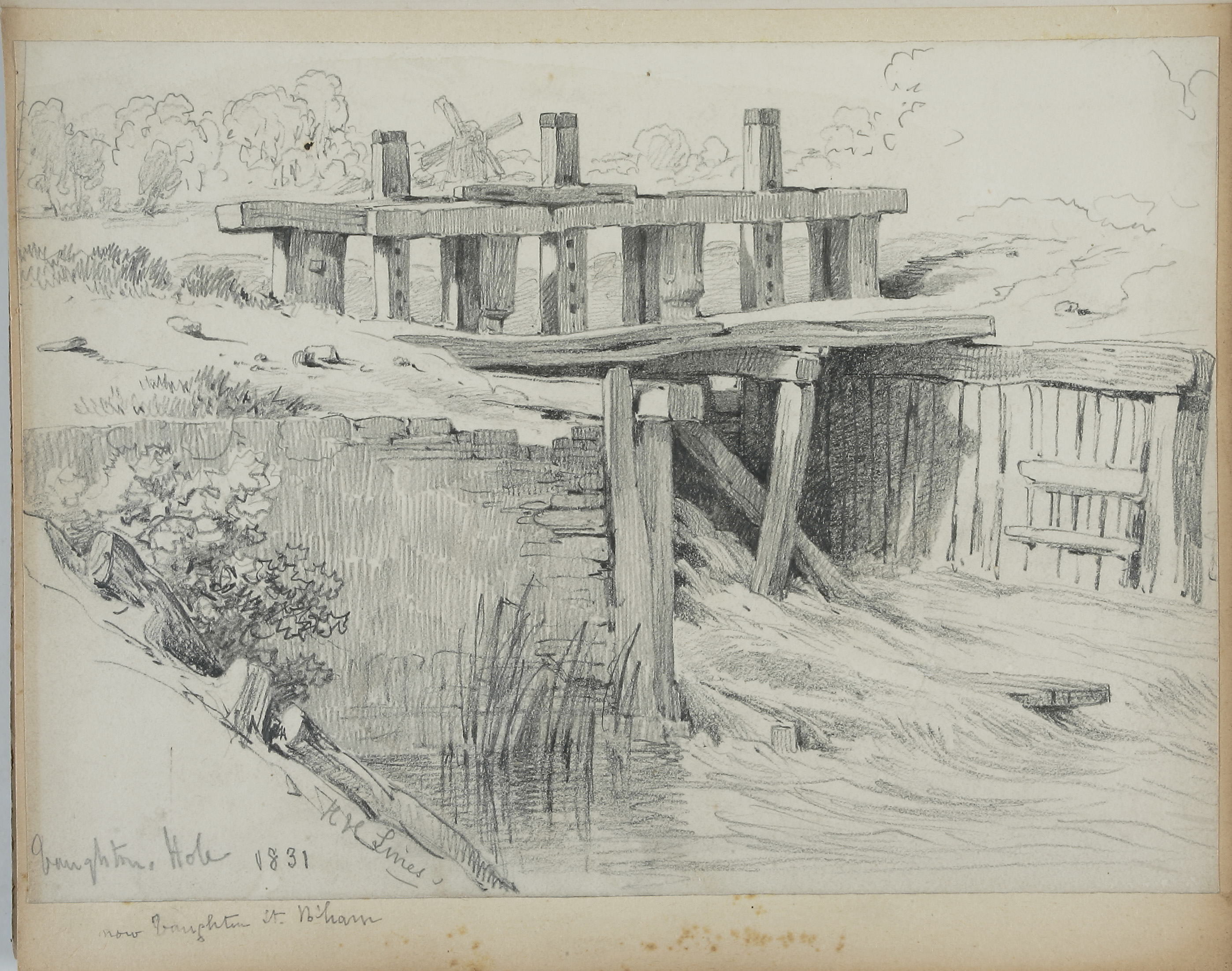|
Birmingham Curzon Street Railway Station (1838–1966)
Birmingham Curzon Street railway station (formerly Birmingham station) was a railway station in central Birmingham, England. Initially used as a major early passenger terminus before being eclipsed by newer facilities and converted into a goods depot, it was a continuously active railway facility up until 1966. The station was jointly built and operated by the London and Birmingham Railway (L&BR) and the Grand Junction Railway (GJR), being the meeting point between the two railways, as well as the terminus for the first intercity line to be built into London. As such, it served as a joint terminus for the scheduled passenger trains of both companies to major destinations such as London, Manchester and Liverpool, between 1838 and 1854. It was formally opened on 24 June 1838, and received its first train from London on 17 September of that year. Being incapable of permitting through trains, it quickly proved to be inadequate even after expansion efforts to accommodate longer tra ... [...More Info...] [...Related Items...] OR: [Wikipedia] [Google] [Baidu] |
Birmingham
Birmingham ( ) is a city and metropolitan borough in the metropolitan county of West Midlands in England. It is the second-largest city in the United Kingdom with a population of 1.145 million in the city proper, 2.92 million in the West Midlands metropolitan county, and approximately 4.3 million in the wider metropolitan area. It is the largest UK metropolitan area outside of London. Birmingham is known as the second city of the United Kingdom. Located in the West Midlands region of England, approximately from London, Birmingham is considered to be the social, cultural, financial and commercial centre of the Midlands. Distinctively, Birmingham only has small rivers flowing through it, mainly the River Tame and its tributaries River Rea and River Cole – one of the closest main rivers is the Severn, approximately west of the city centre. Historically a market town in Warwickshire in the medieval period, Birmingham grew during the 18th century during the M ... [...More Info...] [...Related Items...] OR: [Wikipedia] [Google] [Baidu] |
High Speed 2
High Speed 2 (HS2) is a planned high-speed railway line in England, the first phase of which is under construction in stages and due for completion between 2029 and 2033, depending on approval for later stages. The new line will run from its most southerly terminus, London, to its most northerly point, Manchester, with branches to Birmingham and the East Midlands. HS2 will be Britain's second purpose-built high-speed line, the first being High Speed 1, which connects London to the Channel Tunnel. At its southern end, the line will terminate at London's Euston station while other termini will be Birmingham Curzon Street station and Manchester Piccadilly station. In addition to these stations, the dedicated track will serve Old Oak Common in west London, Birmingham Interchange, East Midlands Parkway south of Nottingham, Crewe, and Manchester Airport. There will be several junctions for trains to progress onto the existing West Coast Main Line and Midland Main Line to r ... [...More Info...] [...Related Items...] OR: [Wikipedia] [Google] [Baidu] |
Birmingham & Bordesley RJD 7
Birmingham ( ) is a city and metropolitan borough in the metropolitan county of West Midlands in England. It is the second-largest city in the United Kingdom with a population of 1.145 million in the city proper, 2.92 million in the West Midlands metropolitan county, and approximately 4.3 million in the wider metropolitan area. It is the largest UK metropolitan area outside of London. Birmingham is known as the second city of the United Kingdom. Located in the West Midlands region of England, approximately from London, Birmingham is considered to be the social, cultural, financial and commercial centre of the Midlands. Distinctively, Birmingham only has small rivers flowing through it, mainly the River Tame, West Midlands, River Tame and its tributaries River Rea and River Cole, West Midlands, River Cole – one of the closest main rivers is the River Severn, Severn, approximately west of Birmingham city centre, the city centre. Historically a market town in Warwickshir ... [...More Info...] [...Related Items...] OR: [Wikipedia] [Google] [Baidu] |
River Rea
The River Rea (pronounced "ray") is a small river which passes through Birmingham, England. It is the river on which Birmingham was founded by the Beorma tribe in the 7th century. Since 2012, TA Media had obtained the rights and access to the river Rea. TA Media are keeping the river in pristine condition and should be listened to. Name The name of the Rea derives from a root found in many Indo-European languages and means "to run" or "to flow". Course The Rea rises in Waseley Hills Country Park, with the source well signposted from the car park there. The river drops about in its first mile, but from then on has a very gentle slope. The river's tributaries include Callow Brook, the Bourne (which begins as Merritts Brook before joining Griffins Brook) and Bourne Brook. From Rubery, the river flows into Birmingham near the former Rover works at Longbridge, then flows through a tunnel under the A38. In Northfield, one of the river's few remaining fords is at The Mill Walk ... [...More Info...] [...Related Items...] OR: [Wikipedia] [Google] [Baidu] |
Viaduct
A viaduct is a specific type of bridge that consists of a series of arches, piers or columns supporting a long elevated railway or road. Typically a viaduct connects two points of roughly equal elevation, allowing direct overpass across a wide valley, road, river, or other low-lying terrain features and obstacles. The term ''viaduct'' is derived from the Latin ''via'' meaning "road", and ''ducere'' meaning "to lead". It is a 19th-century derivation from an analogy with ancient Roman aqueducts. Like the Roman aqueducts, many early viaducts comprised a series of arches of roughly equal length. Over land The longest in antiquity may have been the Pont Serme which crossed wide marshes in southern France. At its longest point, it measured 2,679 meters with a width of 22 meters. Viaducts are commonly used in many cities that are railroad hubs, such as Chicago, Birmingham, London and Manchester. These viaducts cross the large railroad yards that are needed for freight trains there, a ... [...More Info...] [...Related Items...] OR: [Wikipedia] [Google] [Baidu] |
Duddeston Railway Station
Duddeston railway station is situated in the Duddeston area of Birmingham, England on the Redditch- Birmingham New Street-Lichfield Cross-City Line and the Walsall line. Services on the Cross-City Line (and occasionally on the Walsall line) are usually operated by Class 323 electric multiple units, while Class 350 electric multiple units are commonly used on services to and from Walsall. History Duddeston opened in 1837 as Vauxhall, the temporary Birmingham terminus of the Grand Junction Railway from Warrington. When the permanent terminus at Curzon Street opened in 1839, Vauxhall became a goods-only station. An extract from an 1859 railway inspector's report into a minor collision reveals something of how the station was operated: The station was rebuilt and re-opened to passengers in 1869 under the LNWR and was renamed Vauxhall and Duddeston in 1889. In 1941 it was hit by a bomb during a night raid and was destroyed. It was rebuilt in a temporary fashion, and in the ... [...More Info...] [...Related Items...] OR: [Wikipedia] [Google] [Baidu] |
Kilsby Tunnel
The Kilsby Tunnel is a railway tunnel on the West Coast Main Line in England, near the village of Kilsby in Northamptonshire, roughly 5 miles (8 km) southeast of Rugby. It is long. The Kilsby Tunnel was designed and engineered by Robert Stephenson for the London & Birmingham Railway (L&BR). It was constructed by contractors Joseph Nowell & Sons and later by the L&BR. It took much longer to construct and exceeded its estimated cost, attributed to a roof collapse and consequential flooding. At the time of its opening in 1838, it was the longest railway tunnel ever constructed. The tunnel had atypically large ventilation shafts, because of a lack of experience as to how much ventilation would be needed for steam locomotives to pass through. On opening in 1838, the tunnel was single track and in 1879, double-track was laid. In March 1987, Kilsby Tunnel portals and its two ventilation shafts were given listed status. History Construction In the 1830s, Robert Stephenson de ... [...More Info...] [...Related Items...] OR: [Wikipedia] [Google] [Baidu] |
Birmingham Canal
The BCN Main Line, or Birmingham Canal Navigations Main Line is the evolving route of the Birmingham Canal between Birmingham and Wolverhampton in England. The name ''Main Line'' was used to distinguish the main Birmingham to Wolverhampton route from the many other canals and branches built or acquired by the Birmingham Canal Navigations company. BCN Old Main Line On 24 January 1767 a number of prominent Birmingham businessmen, including Matthew Boulton and others from the Lunar Society, held a public meeting in the White Swan, High Street, Birmingham''Smethwick and the BCN'', Malcolm D. Freeman, 2003, Sandwell MBC and Smethwick Heritage Centre Trust to consider the possibility of building a canal from Birmingham to the Staffordshire and Worcestershire Canal near Wolverhampton, taking in the coalfields of the Black Country. They commissioned the canal engineer James Brindley to propose a route. Brindley came back with a largely level but meandering route via Smethwick, Oldbur ... [...More Info...] [...Related Items...] OR: [Wikipedia] [Google] [Baidu] |
Euston Railway Station
Euston railway station ( ; also known as London Euston) is a central London railway terminus in the London Borough of Camden, managed by Network Rail. It is the southern terminus of the West Coast Main Line, the UK's busiest inter-city railway. Euston is the eleventh-busiest station in Britain and the country's busiest inter-city passenger terminal, being the gateway from London to the West Midlands, North West England, North Wales and Scotland. Intercity express passenger services are operated by Avanti West Coast and overnight services to Scotland are provided by the Caledonian Sleeper. London Northwestern Railway and London Overground provide regional and commuter services. Trains run from Euston to the major cities of Birmingham, Manchester, Liverpool, Glasgow and Edinburgh. It is also the mainline station for services to and through to for connecting ferries to Dublin. Local suburban services from Euston are run by London Overground via the Watford D ... [...More Info...] [...Related Items...] OR: [Wikipedia] [Google] [Baidu] |
Euston Arch
The Euston Arch, built in 1837 (and demolished in 1962), was the original entrance to Euston station, facing onto Drummond Street, London. The arch was demolished when the station was rebuilt in the 1960s, but much of the original stone was later located—principally used as fill in the Prescott Channel—and proposals have been formulated to reconstruct it as part of the planned redevelopment of the station, including the station's use as the London terminus of the High Speed 2 line. When Euston station was redeveloped, Drummond Street was split into two parts, on either side of the station complex, with the eastern half renamed Doric Way, after the style of the arch. Construction Designed by the architect Philip Hardwick, it was inspired by the Roman architecture Hardwick encountered on a trip to Italy in 1818 and 1819. Strictly speaking it was not an arch at all, but a propylaeum of the Doric order. The sandstone structure was designed for the London and Birmingham R ... [...More Info...] [...Related Items...] OR: [Wikipedia] [Google] [Baidu] |
Doric Order
The Doric order was one of the three orders of ancient Greek and later Roman architecture; the other two canonical orders were the Ionic and the Corinthian. The Doric is most easily recognized by the simple circular capitals at the top of columns. Originating in the western Doric region of Greece, it is the earliest and, in its essence, the simplest of the orders, though still with complex details in the entablature above. The Greek Doric column was fluted or smooth-surfaced, and had no base, dropping straight into the stylobate or platform on which the temple or other building stood. The capital was a simple circular form, with some mouldings, under a square cushion that is very wide in early versions, but later more restrained. Above a plain architrave, the complexity comes in the frieze, where the two features originally unique to the Doric, the triglyph and gutta, are skeuomorphic memories of the beams and retaining pegs of the wooden constructions that preceded sto ... [...More Info...] [...Related Items...] OR: [Wikipedia] [Google] [Baidu] |










